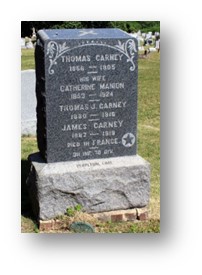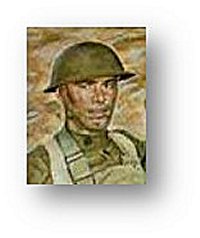Name: Carney, James, Pvt, USA
Local Address: Jackson Street in 1910, Main Street, 1917, Matawan
James Carney’s (possibly originally “Kearney”) family came to the US from Ireland around 1856, with his grandfather Patrick (c.1817-?) appearing on the Matawan census in 1860. James’ father Thomas (1856-1905) was reportedly born in County Tipperary, Ireland. He married Catherine Manion in December of 1876, and the 1880 census placed him, his wife and daughter Mary in South Amboy. Another child, Thomas, came next, followed by daughter Sarah, born in 1884 in Matawan. Our James, the 4th child, was born August 27, 1887 in Matawan, followed by two more children, William and Catherine. Father Tom left the family around 1893, leaving mother Catherine, who worked as a laundress, to support the family. James’ older brother Thomas, JR, was killed by a train while walking on a trestle near Woodbridge in August 1916. His father died at his sister’s residence in Matawan in 1905 and was identified as a “character” in his obituary.
Little is known of James’ early life. He may have been enrolled in the Matawan school system but no record supports this. When he registered for the draft in June of 1917, he was described as being of medium height and build, with grey eyes and light brown hair, and was a laborer for Monmouth County.
In February of 1918, he reported to Fort Dix for induction into the army, with the Red Cross providing him a sweater, helmet, scarf and wristlet. Assigned to the Supply Company of the 311th Infantry Regiment, he shipped to France with his regiment on May 20, 1918 aboard the SS Vestris (this ship made national news when it sank off the Virginia Capes on November 11, 1928 on a trip from New York to Montevideo, with over 130 passengers and crew drowning.)
 His unit was involved in the St. Mihiel offensive. The 311th, part of the 78th Division, was attached to the 1st US Army Corps during this engagement. James was assigned as a waggoneer, a dangerous position involving the movement of men and supplies between the rear areas and front trench lines, leaving them exposed and vulnerable to enemy artillery.
His unit was involved in the St. Mihiel offensive. The 311th, part of the 78th Division, was attached to the 1st US Army Corps during this engagement. James was assigned as a waggoneer, a dangerous position involving the movement of men and supplies between the rear areas and front trench lines, leaving them exposed and vulnerable to enemy artillery.
The war ended the following November, but the US troops had another threat they had to deal with, the Spanish Influenza epidemic that fall. With the concentration of so many non-immune individuals in close quarters, the conditions for the disease’s spread were optimal. While the epidemic peaked in October and November of 1918, it remained in effect in the camps throughout 1919. James apparently caught it and died of lobar pneumonia on February 7, 1919 in France. (It is noted that another Matawan boy, waggoneer Charles Dexter of the 310th regiment, died of the flu the next day – their deaths were reported together in the Matawan Journal.)
James was buried in the American Cemetery in Semur, Cote d’Or, France. Disinterred November 21, 1921, he was returned to the United States aboard the SS Crook with the remains of 662 other US servicemen. His body was received by undertaker William Arrowsmith in Matawan in mid-January 1922. James’ funeral was held at St. Joseph’s Church in Keyport, and he was buried in the church’s cemetery. No photograph has been located of him.


NO COMMENTS